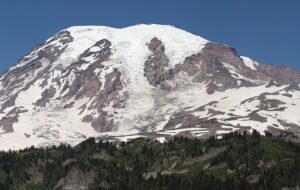On Jan. 5, Adam Kaniak and Riso Nemec of Slovakia climbed one of the most emblematic walls in the Julian Alps, the 900m north wall of 2,472m Spik.
Climbing simultaneously, the duo went up the Direktna smer route. After the seven-hour ascent, Kaniak and Nemec rated the difficulty of the line as AI5+. Nemec said they had fantastic conditions in the mountain.

The ‘Direktna smer’ route on the north wall of Spik. Photo: SHS JAMES/Facebook
The Direktna was first climbed on Sept. 5-6, 1926 by Mira Marko Debelak and her climbing partner, Stanko Tominsek. It was one of the most important climbs of the time in Europe. Debelak was one of the most successful alpinists between the two World Wars and became the first female member of the Austrian Academic Club.
The route was first repeated in 1927 by Edo Derzaj and Stane Hudnik, and later by other well-known climbers, including Francek Knez (1978), Nejc Zaplotnik (1979), and Igor Mezgec (1981), among others.

Kaniak and Nemec on the Direct route up Spik. Photo: SHS JAMES/Facebook
Spik is a pyramidal peak located in Slovenia’s eastern Julian Alps. Its name, “spike,” derives from its pointed shape. The normal route follows the southern slope, while the north side of the peak is very difficult. There are at least 15 routes on the mountain, and Direktna is the most challenging. Although Spik is not the tallest peak in its group, its formidable north wall has long attracted admiration.

On the 900m direct route on Spik. Photo: SHS JAMES/Facebook
1952 disaster
The greatest tragedy in the history of Slovenian mountaineering happened on that same north face in 1952. That spring, to celebrate May 1, a group of young mountaineers wanted to hike on Spik. They first targeted another route, but later they changed their objective and headed up the north face.
In the meantime, it started to rain. The young mountaineers, divided into two groups, decided to turn around. However, on their way down, one of them slipped, pulling his partner off the wall with him. They fell 200m and died. When the other three saw the accident, they secured themselves to the wall and waited for rescue.
The next afternoon, other members of the divided team, who were in a mountain hut, called rescue services. However, due to bad weather, the rescue could not start until the next day, more than two days after the accident.
Since then, one of the mountaineers on the wall had died due to exposure, while two were still alive. Then the weather worsened again. One more young climber died before rescuers could reach them. A fifth died during the rescue. All five victims were between 21 and 25 years old, including three brothers.

Spik in Slovenia’s Julian Alps. Photo: Wikimedia






